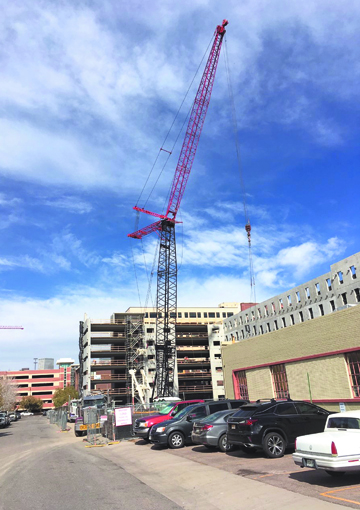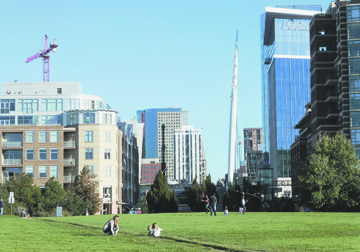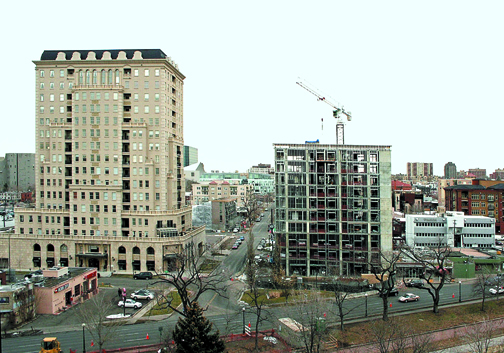The Long-Term Viability Of Fast-Delivery Denver Apartment Buildings
by Luke Schmaltz

Although the official Colorado state bird is the Lark Bunting, it has seemingly been replaced across the greater Denver metro area by the crane. For the past several years, the Mile-High City skyline has become increasingly dotted with these towering industrial effigies — as long-standing, recently demolished structures are replaced with mid-rise odes to blandness. These rapidly erected residential buildings have earned disparaging nicknames from journalists and pedestrian critics alike such as fugly, McUrbanist, fast-casual architecture, contemporary contempt, LoMo (low modern), blandmarks and spongebuild squareparts.
A New Development

In 2015, Denver adopted the International Building Code (IBC) which allows for podium-style mid-rise residential buildings to be primarily constructed of wood rather than concrete and steel. The new code meant that a two-story concrete base known as a “podium” could be vertically succeeded by up to five levels of wood-framed construction. This, in turn, opened the door for a host of money-saving dynamics such as unspecialized labor, cost-effective raw materials and quicker completion timelines.
A Nationwide Trend
This generic approach to residential development is not unique to Denver, rather, it is a trend rearranging the personalities of inner cities from Seattle to Austin and Minneapolis to Charlotte. The rising costs of land, labor and certain building materials has made wood framing the default method of construction — allowing for the creation of a business model with an attractive bottom line even though the product itself is anything but.
Supply And Demand

According to The Denver Post, area developers had 26,916 apartment units under construction at the end of 2018, with a projected minimum of 12,000 units to be built every year for the foreseeable future. This number is dwarfed by projections from Cary Bruteig, owner of Denver’s Apartment Insights, a data reporting company that expects 2019 apartment construction to render upward of 25,700 units in 2019.
The phenomenon of cheaply resourced, quickly erected residential structures gives rise to the issue of longevity. Will these light-frame, wood fortified dwellings with flat window facades and multi-colored exterior panels maintain their appeal at the same price point into the next decade? A surging demand for affordable housing meets that question with a resounding “yes.” Yet, in the event of a recession or if cheap construction proves to fail the test of time, these aesthetic atrocities may prove to be the 21st Century equivalent of 19th century balloon-frame buildings — which were defined as being poorly maintained, substandard housing for the lowest social rung of tenancy just above homeless. Lest history forget, these structures were reduced to ash in tragic events such as the San Francisco Fire of 1851 and the Great Chicago Fire of 1871.
The Price Of Cost-Effective Construction
While lack of aesthetic appeal and inflated prices brought on by high demand are obvious drawbacks, economically built wood frame construction buildings also carry several subsurface concerns. Structures of this sort are susceptible to moisture being drawn into wall cavities, where it can become trapped and foster wood rot due to humidity and the growth of mold. The latter, in turn, can cause allergic and asthmatic reactions from occupants. Wood framed buildings are also known for attracting termites, having low thermal mass (ability to retain heat), offering poor sound insulation between units, being vulnerable to fire damage and emitting volatile organic and chemical compounds which diminish indoor air quality.
Distractions Abound

In a preemptive strategy to counter this possibility, many developments are attracting top dollar clientele by offering deluxe, high-end amenities. Luxuries such as on-site car washes, dry cleaners, full-range fitness centers, work-from-home office areas, dog runs, complementary weekend brunches and valet trash services aim to disguise the fact that most tenants are living in identical boxes built by unskilled workers laboring at breakneck speed. These overpriced cookie cutter domiciles include few, if any features which discern one unit from another and zero signs of craftsmanship, personalization or style. Many excited tenants, however, are far too distracted by innovative diversions such as goat yoga, Zen gardens, tanning beds, old-school video arcades, bowling alleys and free beer.
High-End On The Rise
An abundance of amenities, perks, on-site attractions, as well as the inimitable allure of being the first tenant in a new apartment, all add to the exorbitant rental prices brought on by a high demand for housing. A new rental in a high-end downtown Denver facility can run pretty high — such as $7,000+ for 1,324 square feet at Union Denver to $15,000 or more per month for a penthouse suite at The Confluence. Of course, not all rates are mouth-droppingly Manhattan-esque, as many units appeal to a more philistine price point such as a studio at The Verve on Delgany for just $1,563 or a studio at the Country Club Towers on Bayaud for a mere $1,855.
A Long-Term Diagnosis
The professional opinion of master carpenter Richard Welker sheds some long-term light on the subject of sustainability. Welker, a longtime Denver resident who recently relocated to Portland, has personally worked on hundreds of wood-frame apartment units. He attests “lumber isn’t what it used to be, but long-term, you can always repair the guts of something that is made of wood. Theoretically, if stringent maintenance protocols are followed, these buildings could last a really long time.” This statement clearly places long-term viability on building owners and managers, and whether they continue to be inhabited long after their new veneer has worn away depends on what, if any, aesthetic taste tenants may have. Plainly put, if people are willing to pay to rent dwellings that are ugly and overpriced, they will continue to dominate the rental marketplace and the skylines of inner city, U.S.A.
